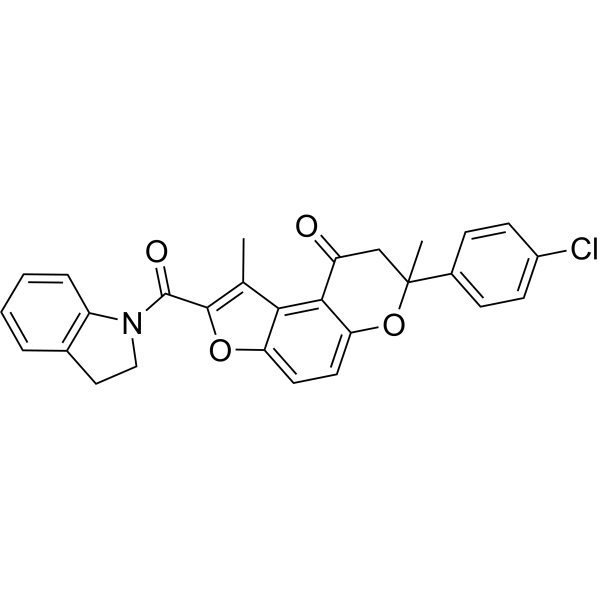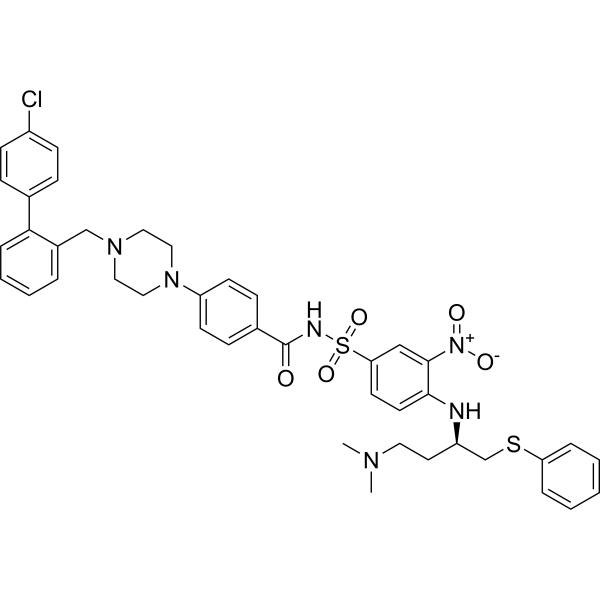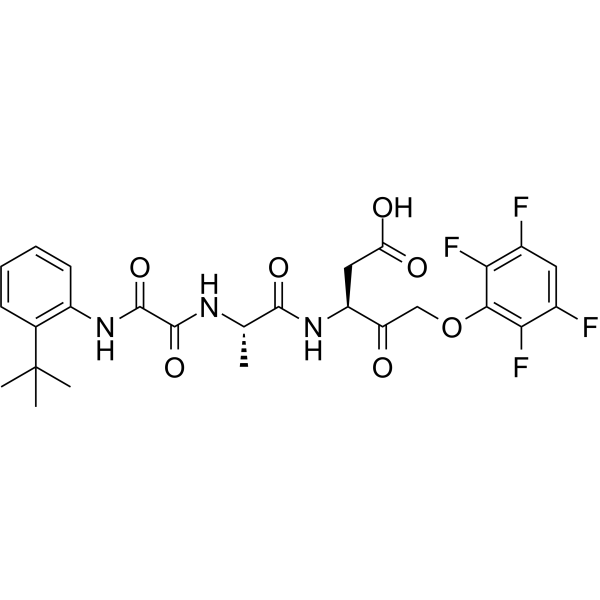 To enhance service speed and avoid tariff delays, we've opened a US warehouse. All US orders ship directly from our US facility.
To enhance service speed and avoid tariff delays, we've opened a US warehouse. All US orders ship directly from our US facility.
| Cat. No. | Product Name | Field of Application | Chemical Structure |
|---|---|---|---|
| DC72584 | M47 Featured |
M47 is a small molecule that selectively destabilizes Cryptochrome 1 (CRY1) and increases degradation of the CRY1 in the nucleus. M47 enhances apoptosis in Ras-transformed P53-deficient mouse skin fibroblast lines and enhances life span in p53 knockout mice. M47 can be used in research of cancer.
More description
|

|
| DC1022 | ABT-737 Featured |
ABT-737 is a BH3 mimetic inhibitor of Bcl-xL, Bcl-2 and Bcl-w with EC50 of 78.7 nM, 30.3 nM and 197.8 nM, respectively.
More description
|

|
| DC9762 | Emricasan Featured |
Emricasan (IDN-6556, PF-03491390) is a potent irreversible pan-caspase inhibitor.
More description
|

|
| DC73101 | GSK137 Featured |
GSK137 is a potent, small-molecule BCL6 inhibitor binding to BCL6 BTB-POZ domain, displaces peptides derived from the human SMRT co-repressor from the BCL6 BTB-POZ domain in a TR-FRET assay with a pIC50 of 8.0.
More description
|

|
| DC73130 | AC-003 Featured |
AC-003 is a novel, orally administered small-molecule inhibitor targeting receptor-interacting protein kinase 1 (RIPK1), demonstrating therapeutic potential for the treatment of idiopathic pulmonary fibrosis (IPF).
More description
|

|
| DC76161 | Resolvin D2 n-3 DPA |
Resolvin D2 n-3 DPA is a specialized proresolving mediator (SPM). Resolvin D2 n-3 DPA (1 nM) can reduce the chemotaxis and adhesion of human neutrophils induced by TNF-α. Resolvin D2 n-3 DPA (100 ng/mouse; intravenous injection) can reduce neutrophil infiltration in the peritoneum and the levels of IL-6 and the chemokine (C-C motif) ligand 2 (CCL2) in a mouse model of inflammation induced by zinc oxide.
More description
|

|
| DC76160 | NSC 15830 hydrochloride |
NSC 15830 (S-(1,2-Dichlorovinyl)-L-cysteine) hydrochloride is a nephrotoxin and metabolite of trichloroethylene. NSC 15830 hydrochloride inhibits pathogen-stimulated TNF-α.
More description
|

|
| DC76159 | MG-C-30 |
MG-C-30 is an orally active agonist for CD27 with an EC50 of 0.84 μM. MG-C-30 activates NK cells and T cell co-stimulatory signals, and enhances immune response. MG-C-30 exhibits antitumor efficacy in mouse EG7-OVA model.
More description
|

|
| DC76158 | CC-1069 |
CC-1069, a structural analog of thalidomide in rats.
More description
|

|
| DC76157 | 2-O-Methyl PAF C-16 |
2-O-Methyl PAF C-16 (ET-18-O-OCH3), a structural analog of the mediator of inflammation platelet-activating factor (PAF), is a cytotoxic ether lipid. 2-O-Methyl PAF C-16 stimulates TNF-α release in murine macrophages.
More description
|

|
| DC76156 | Fosizensertib |
Fosizensertib is the inhibitor for RIP-1 kinase and can be used in researchs of ulcerative colitis.
More description
|

|
| DC76155 | Cl-Necrostatin-1 |
Cl-Necrostatin-1 is a RIPK1 inhibitor. Cl-Necrostatin-1 can also inhibit TNF-α-induced necroptosis in Jurkat cells deficient in Fas-associated death domain protein (FADD; EC50 = 180 nM), a modification that prevents caspase activation in response to death-domain receptor signaling. Cl-Necrostatin-1 can also reduce infarct size in a mouse model of middle cerebral artery occlusion (MCAO). Cl-Necrostatin-1 is used for research in cardiovascular and cerebrovascular diseases.
More description
|

|
| DC76154 | CST530 |
CST530 is an inhibitor of apoptosis protein (IAP) antagonist. CST530 is an IAP-type Ligands for E3 Ligase. CST530 binds to the BIR3 domain of IAP and interferes with its function, thereby promoting the ubiquitination and degradation of cIAP1. CST530 can be used to prepare PROTACs.
More description
|

|
| DC76153 | UAMC-4821 |
UAMC-4821 is an inhibitor for ferroptosis with an IC50 of 5.2 nM. UAMC-4821 scavenges free radicals, blocks the lipid peroxidation, inhibits ML162. Emavusertib maleate is an orally active inhibitor for IRAK4 (IC50=57 nM) and FLT3. Emavusertib maleate inhibits NF-κB and MyD88 signaling pathways, reduces the generation of pro-inflammatory cytokines like IL-6 and IL-10, thereby exhibiting anti-inflammatory and anti-proliferative activities against cancer cells, leading to cell apoptosis. Emavusertib maleate exhibits antitumor activity in mouse model.
More description
|

|
| DC76152 | Pro-GA |
Pro-GA is a γ-Glutamylcyclotransferase (GGCT) inhibitor and a cell-permeable diester-type pro-drug with anticancer activity, GGCT is a key enzyme in glutathione metabolism and is involved in the ferroptosis pathway. Pro-GA exhibits an IC50 of 57 μM against the bladder cancer cell line T24 and can be utilized in cancer research.
More description
|

|
| DC76151 | NYY-6a |
NYY-6a is a Ferroptosis inhibitor. NYY-6a shows significant inhibitory activity against RSL3-induced ferroptosis across 786-O and HT-1080 cells with EC50s of 52 and 50 nM, respectively. NYY-6a functions as a radical trapping antioxidant (RTA) with efficacy of diminishing lipid peroxidation comparable to ferrostatin-1 and liproxtatin-1. NYY-6a is potential for ferroptosis related pathologies reasearch.
More description
|

|
| DC76150 | Ferroptosis inducer-7 |
Ferroptosis inducer-7 is an orally active and selective ferroptosis inducer via inositol 1,4,5-trisphosphate receptor (IP3R)/calcium release-activated calcium channel protein (ORAI). Ferroptosis inducer-7 exhibits a notable effect in alleviating anemia symptoms, suppressing bone marrow CTLs activation, and improving hematopoietic function in immune-mediated bone marrow failure. Ferroptosis inducer-7 can be studied in research for aplastic anemia.
More description
|

|
| DC76149 | Ferroptocide |
Ferroptocide is a cell death inducer that triggers ferroptosis and has anti-tumor activity. Ferroptocide can induce oxidative stress, leading to G2/M cell cycle arrest and apoptosis activation in LNCaP cells, while also effectively inhibiting the cell viability of both LNCaP and TRAMP-C1 cells. Ferroptocide can be used to study its capability to induce mitochondrial autophagy and to trigger immunogenic cell death (ICD) in prostate cancer cells.
More description
|

|
| DC76148 | FerroLOXIN-1 |
FerroLOXIN-1 is a potent inhibitor of 15LOX-2 that selectively blocked production of pro-ferroptotic HOO-ETE-PE and protected against RSL3-induced ferroptosis. FerroLOXIN-1 closely interacted therein with 15LOX-2 only, and in particular with Y154, N155, W158.
More description
|

|
| DC76147 | CT-1 |
CT-1 is a derivative of Cryptotanshinone. CT-1 is a ferroptosis inducer. CT-1 promotes the interaction between NCOA4 and ferritin by targeting FTH1, triggering ferritinophagy-mediated ferroptosis. CT-1 has anticancer activity against triple-negative breast cancer (TNBC). CT-1 induces ferroptosis in both N2-type tumor-associated neutrophils (TANs) and TNBC cancer cells.
More description
|

|
| DC76146 | Z-VAD |
Z-VAD is a competitive, irreversible pan-caspase inhibitor with broad specificity and weakly inhibits caspase-2. It induces autophagy and necrosis in irradiated breast and lung cancer models.
More description
|

|
| DC76145 | LPT99 |
LPT-99 is an antagonist of apoptotic protease activating factor 1 (APAF-1). LPT-99 suppresses the activation of procaspase-9. LPT99 suppresses Cisplatin.
More description
|

|
| DC76144 | CAY10406 |
CAY10406 is an inhibitor for caspase 3/7. CAY10406 inhibits the expression of 28-kDa IL-1β fragment, without significant cytotoxicity (10 μM).
More description
|

|
| DC76143 | Ac-DEVD-CHO TFA |
Ac-DEVD-CHO TFA is a peptide inhibitor of caspase-3 (Ki=230 pM) and caspase-7. Ac-DEVD-CHO TFA reduces caspase-3 activity and apoptosis induced by Prostaglandin E2.
More description
|

|
| DC76142 | WH244 |
WH244 is a second-generation PROTAC that selectively degrades the anti-apoptotic proteins BCL-xL and BCL-2 with a DC50 of 0.6 nM for BCL-xL and 7.4 nM for BCL-2.
More description
|

|
| DC76141 | Δ8-Tetrahydrocannabinoquinone |
Δ8-Tetrahydrocannabinoquinone (HU-336) is a potent antiangiogenic agent. Δ8-Tetrahydrocannabinoquinone inhibits angiogenesis by directly inducing apoptosis of vascular endothelial cells without changing the expression of pro- and antiangiogenic cytokines and receptors. Δ8-Tetrahydrocannabinoquinone is highly effective against tumor xenografts in nude mice.
More description
|

|
| DC76140 | β-Eleostearic acid |
β-Eleostearic acid is an apoptosis inducer with antiproliferative properties. β-Eleostearic acid down-regulates and up-regulates the mRNA levels of Bcl-2 and Bax, respectively.
More description
|

|
| DC76139 | ZSH-512 |
ZSH-512 is a potent RARγ inhibitor. ZSH-512 shows antiproliferation activity. ZSH-512 induces apoptosis. ZSH-512 decreases CD133, NANOG, SOX2, and EPCAM protein expression. ZSH-512 shows anticancer activity. ZSH-512 has the potential for the research of colorectal cancer.
More description
|

|
| DC76138 | TZOA |
TZOA is an antiviral agent that inhibits the replication of infectious hematopoietic necrosis virus (IHNV) in a dose-dependent manner and significantly reduces viral titers. TZOA can effectively counteract IHNV-induced apoptosis, maintain mitochondrial membrane potential and homeostasis, and restore MAVS-mediated interferon expression. TZOA has antiviral activity.
More description
|

|
| DC76137 | TG101209 analog 1 |
TG101209 analog 1 (Compound 8h) is an inhibitor for BUB1B with an IC50 of 10.36 μM. TG101209 analog 1 exhibits cytotoxicity (IC50 for Caki-1 is 1.347 μM), induce necrosis and apoptosis.
More description
|

|